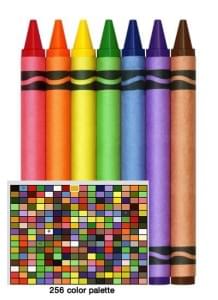These days, there’s a framework for everything, and it seems that before we can even digest one, another one is released. This holds particularly true when it comes to CSS grid layouts, and there’s no shortage of frameworks deemed “the best, most lightweight to date”. This overdose of information can baffle us, and leave us wondering if frameworks like HTML9 Responsive Boilerstrap JS are really the way to go.
Let’s step back and breathe a bit, and ask ourselves a question: Are we really going to use every one of those 24 variants and the million sub-variants that “That Great Framework” ships with? Often we need only a simple flexible solution with a few variants to work in our project, and with a strong command of the basics we can extend as we see fit. I’m going to present four different techniques for developing your own CSS grid, and each of them are easily extendable. Here are the four methods:
- Responsive grid layout, v1 (using negative margins)
- Responsive grid layout, v2 (using
box-sizing: border-box) - Responsive grid layout using table display
- Responsive grid layout using flexbox
I’m going to simplify these methods by using minimal amounts of easy, understandable CSS. A CodePen demo will be provided with each example, so you can fork and/or play with the CSS in the demos. Let’s dive in.
Note: I’ve included embedded demos for each but in order to see the full responsive nature of each technique, it’s best to view the CodePen demos at full screen by clicking on the “edit on CodePen” link at the top of each demo.
Common CSS
Before we dig in to each method, let’s take a look at some common CSS we’ll use. We’ll be using the box-sizing: border-box declaration universally across our document, and we’ll also implement a .clearfix class for clearing floats. Here’s our base CSS:
/* resets */
*,
*:before,
*:after {
box-sizing: border-box;
}
.clearfix:after {
content: "";
display: table;
clear: both;
}In case any vendor prefixes are necessary, we’ll be using CodePen’s Autoprefixer feature to fill those in for us. Let’s now get into the first of our four methods.
Method 1: Using Negative Margins
This method makes use of negative margins to create CSS grid blocks with a fixed margin in between each block. The negative margin varies depending on the position of the grid block, and the margin in between grid blocks remains fixed. Let’s first look at the HTML:
<div class="row-2 clearfix">
<div class="col-1-2"></div>
<div class="col-1-2"></div>
</div><!-- /.row -->
<div class="row-4 clearfix">
<div class="col-1-4"></div>
<div class="col-1-4"></div>
<div class="col-1-4"></div>
<div class="col-1-4"></div>
</div><!-- /.row -->
<div class="row-8 clearfix">
<div class="col-1-8"></div>
<div class="col-1-8"></div>
<div class="col-1-8"></div>
<div class="col-1-8"></div>
<div class="col-1-8"></div>
<div class="col-1-8"></div>
<div class="col-1-8"></div>
<div class="col-1-8"></div>
</div><!-- /.row -->And our CSS:
/* grid */
[class*="row-"] {
margin-bottom: 20px;
}
[class*="row-"]:last-child {
margin-bottom: 0;
}
[class*="col-"] {
}
@media all and ( min-width: 768px ) {
/* all cols margin */
[class*="col-"] {
margin-right: 20px;
}
[class*="col-"]:last-child {
margin-right: 0;
}
/* make the columns responsive */
.col-1-2 {
float: left;
width: 50%;
}
.col-1-4 {
float: left;
width: 25%;
}
.col-1-8 {
float: left;
width: 25%;
}
/* 2 span rows */
.row-2 {
padding-left: 20px;
}
.row-2 [class*="col-"]:first-child {
margin-left: -20px;
}
/* 4 span rows */
.row-4 {
padding-left: 60px;
}
.row-4 [class*="col-"]:first-child {
margin-left: -60px;
}
/* 8 span rows */
.row-8 {
padding-left: 60px;
}
.row-8 [class*="col-"]:nth-child(4n+1) {
margin-left: -60px;
}
.row-8 [class*="col-"]:nth-child(5n-1) {
margin-right: 0;
}
.row-8 [class*="col-"]:nth-child(6n-1) {
clear: both;
}
}
@media all and ( min-width: 1200px ) {
/* adjust width */
.col-1-8 {
float: left;
width: 12.5%;
}
/* 8 span rows */
.row-8 {
padding-left: 140px;
}
/* reset these... */
.row-8 [class*="col-"]:nth-child(4n+1) {
margin-left: 0;
}
.row-8 [class*="col-"]:nth-child(5n-1) {
margin-right: 20px;
}
.row-8 [class*="col-"]:nth-child(6n-1) {
clear: none;
}
/* and add this */
.row-8 [class*="col-"]:nth-child(1) {
margin-left: -140px;
}
}And here’s the CodePen demo:
See the Pen ncDxo by SitePoint (@SitePoint) on CodePen.
As you can see, when we hit the responsive breakpoint, a fixed margin value (let’s call it x) multiplied by the number of columns minus 1 (n-1) is added to the left of the row. Each column has a right margin of x, except the last child. And the first child has a negative margin of (n-1)*(x).
Shortcomings and Bugs
Some math is required for this method, and becomes impractical as the number of grid items increases. Also, when we extend it on multiple column steps (example going from 1 per row, to 4, to 8), we have to reset the CSS and a lot of nth-child math gets involved.
Another interesting bug occurs when there are multiple floated elements. The combined sum of margins at some point clash, bumping columns at the end onto a new line. This can be seen in the 8-column scenario. If we change the final media query minimum width to less than 1200px, we can see the bug in action. Be mindful of this. There are benefits to this technique though.
Benefits and Real World Uses
The real beauty of this technique though lies in creating fixed/fluid grid combinations. As an example, let’s imagine a fluid width primary content area and a secondary fixed-width aside area. Our HTML might look like this:
<div class="container clearfix">
<div class="primary">
<h2>Primary</h2>
Lorem ipsum dolor...
</div>
<div class="secondary">
<h2>Secondary</h2>
Lorem ipsum dolor...
</div>
</div><!-- /.container -->And our CSS like this:
/* layout */
.primary {
margin-bottom: 20px;
}
@media all and ( min-width: 600px ) {
.container {
padding-right: 300px;
}
.primary {
float: left;
padding-right: 60px;
width: 100%;
}
.secondary {
float: right;
margin-right: -300px;
width: 300px;
}
}Here’s a CodePen demo to see it in action:
See the Pen vADjn by SitePoint (@SitePoint) on CodePen.
Method 2: Using box-sizing: border-box
This method leverages the full power of the box-sizing: border-box declaration. Because this feature allows us to pad an element without adding to the element’s overall width, we can still achieve a flexible grid with fixed “margins”. This time, instead of using the margin property, the inner padding values will act as the margins for our grid items. Let’s look at some HTML:
<div class="row clearfix">
<div class="col-1-2"></div>
<div class="col-1-2"></div>
</div><!-- /.row -->
<div class="row clearfix">
<div class="col-1-4"></div>
<div class="col-1-4"></div>
<div class="col-1-4"></div>
<div class="col-1-4"></div>
</div><!-- /.row -->
<div class="row clearfix">
<div class="col-1-8"></div>
<div class="col-1-8"></div>
<div class="col-1-8"></div>
<div class="col-1-8"></div>
<div class="col-1-8"></div>
<div class="col-1-8"></div>
<div class="col-1-8"></div>
<div class="col-1-8"></div>
</div><!-- /.row -->We won’t require any crazy math here either, so our CSS becomes really simple. Here it is, for up to eight columns:
/* grid */
.row {
margin: 0 -10px;
margin-bottom: 20px;
}
.row:last-child {
margin-bottom: 0;
}
[class*="col-"] {
padding: 10px;
}
@media all and ( min-width: 600px ) {
.col-2-3 {
float: left;
width: 66.66%;
}
.col-1-2 {
float: left;
width: 50%;
}
.col-1-3 {
float: left;
width: 33.33%;
}
.col-1-4 {
float: left;
width: 25%;
}
.col-1-8 {
float: left;
width: 12.5%;
}
}The negative left and right margins on each row are to compensate for the padding on the columns. At a specified media query minimum width, our grid items take on their own width and become floated inside their containers. You may choose to alter this width as you please, and specifying a different media query breakpoint for different groups of grid items is a breeze too.
Here’s a demo:
See the Pen Easy Responsive CSS Grid Layout, Version 2: Using box-sizing by SitePoint (@SitePoint) on CodePen.
Extending This Method
Let’s say you wanted the .col-8 items to jump to 4 per row, then 8 per row. With a little thought, it’s very easy. Assuming the same markup as above, our CSS would look like this:
@media all and ( min-width: 600px ) {
.col-1-8 {
float: left;
width: 25%;
}
.col-1-8:nth-child(4n+1) {
clear: both;
}
}
@media all and ( min-width: 960px ) {
.col-1-8 {
width: 12.5%;
}
.col-1-8:nth-child(4n+1) {
clear: none;
}
}Here’s the Demo:
See the Pen Easy Responsive CSS Grid Layout, Version 2b: 1 to 4 to 8 by SitePoint (@SitePoint) on CodePen.
Method 3: Using Table Display
This method implements the age-old table functionality, but without breaking our semantics or structure. In this method, the visible elements are block-level by default. But at a certain breakpoint, grid rows become tables and columns become table cells. Let’s look at the markup — it’s similar to method 2, but no clearfix is required:
<div class="row">
<div class="col-1-2"></div>
<div class="col-1-2"></div>
</div><!-- /.row -->
<div class="row">
<div class="col-1-4"></div>
<div class="col-1-4"></div>
<div class="col-1-4"></div>
<div class="col-1-4"></div>
</div><!-- /.row -->
<div class="row">
<div class="col-1-8"></div>
<div class="col-1-8"></div>
<div class="col-1-8"></div>
<div class="col-1-8"></div>
<div class="col-1-8"></div>
<div class="col-1-8"></div>
<div class="col-1-8"></div>
<div class="col-1-8"></div>
</div><!-- /.row -->And here’s the CSS:
/* grid */
.row {
margin: 0 -10px;
margin-bottom: 10px;
}
.row:last-child {
margin-bottom: 0;
}
[class*="col-"] {
padding: 10px;
}
@media all and ( min-width: 600px ) {
.row {
display: table;
table-layout: fixed;
width: 100%;
}
[class*="col-"] {
display: table-cell;
}
/* set col widths */
.col-2-3 {
width: 66.66%;
}
.col-1-2 {
width: 50%;
}
.col-1-3 {
width: 33.33%;
}
.col-1-4 {
width: 25%;
}
.col-1-8 {
width: 12.5%;
}
}And our demo:
See the Pen Easy Responsive CSS Grid Layout, Version 3: Table Display by SitePoint (@SitePoint) on CodePen.
This method may seem convoluted, but there are benefits. For starters, we’re not breaking semantics by using traditional table layouts, and we don’t have to clear floats. Equal height columns are also a breeze. Flexible and fluid-width combinations? No problem. Table display brings issues of its own though, and is my least favourite out of these four methods — even though it’s sometimes a good option.
Method 4: Flexbox
The last method that I’ll present uses the flexbox module. According to MDN:
The CSS3 Flexible Box, or flexbox, is a layout mode providing for the arrangement of elements on a page such that the elements behave predictably when the page layout must accommodate different screen sizes and different display devices.
Flexbox presents us with a host of different features that give us a powerful arsenal of layout options. Making a flexbox module responsive is an absolute breeze. As before, our markup looks like this:
<div class="row">
<div class="col-1-2"></div>
<div class="col-1-2"></div>
</div><!-- /.row -->
<div class="row">
<div class="col-2-3"></div>
<div class="col-1-3"></div>
</div><!-- /.row -->
<div class="row">
<div class="col-1-4"></div>
<div class="col-1-4"></div>
<div class="col-1-4"></div>
<div class="col-1-4"></div>
</div><!-- /.row -->
<div class="row">
<div class="col-1-8"></div>
<div class="col-1-8"></div>
<div class="col-1-8"></div>
<div class="col-1-8"></div>
<div class="col-1-8"></div>
<div class="col-1-8"></div>
<div class="col-1-8"></div>
<div class="col-1-8"></div>
</div><!-- /.row -->Here’s a look now at our CSS:
/* grid */
.row {
display: flex;
flex-flow: row wrap;
margin: 0 -10px;
margin-bottom: 10px;
}
.row:last-child {
margin-bottom: 0;
}
[class*="col-"] {
padding: 10px;
width: 100%;
}
@media all and ( min-width: 600px ) {
/* set col widths */
.col-2-3 {
width: 66.66%;
}
.col-1-2 {
width: 50%;
}
.col-1-3 {
width: 33.33%;
}
.col-1-4 {
width: 25%;
}
.col-1-8 {
width: 12.5%;
}
}And the CodePen demo:
See the Pen Easy Responsive CSS Grid Layout, Version 4: Flexbox by SitePoint (@SitePoint) on CodePen.
This time, we need to set the display property to flex on the rows, and also specify the flex-flow property. Full definitions and descriptions of these properties are available in MDN’s flexbox documentation. At our responsive breakpoint, we switch our column widths, and flexbox handles the rest. Neat!
Wrap Up
We’ve looked at 4 unique ways to create a responsive CSS grid system, each with its own benefits. There’s no “best” way to do anything, and I often find myself in situations where one is more efficient than the other, or I need to combine both. Methods 1 and 2 are my preferred ones, and I use them together a lot in the same projects (defining main layouts with method 1, and responsive grids with method 2).
Method 3 has its benefits too as mentioned above, but I personally tend to resort to table-based layouts only when absolutely necessary. Method 4 is simply beautiful, and I long for the day when I can freely implement it across all projects. Flexbox is on the move, but is supported only by IE10 and up. There are polyfills available, but I prefer to shy away from polyfills in general. Know your market though; there are scenarios today where flexbox does indeed provide the perfect solution.
Each of these methods is easily scalable and expandable. With the thought processes presented above, you should have no problem at all setting up a grid tailor-made to your project with minimal amounts of CSS. The CSS Grid Module is also on the way, but it’ll be a while before we consider implementing it. I hope you enjoyed reading this, and are now less intimidated by CSS grids!
Frequently Asked Questions (FAQs) on Easy Responsive CSS Grid Layouts
What is the difference between CSS Grid and Flexbox?
CSS Grid and Flexbox are both powerful layout systems in CSS. While they can be used interchangeably in some cases, they each have their unique strengths. Flexbox is a one-dimensional layout model, and it is particularly suited for distributing items along a single row or column. CSS Grid, on the other hand, is a two-dimensional layout system, making it ideal for designing complex web layouts with rows and columns.
How can I make my CSS Grid layout responsive?
To make a CSS Grid layout responsive, you can use the ‘fr’ unit, which represents a fraction of the available space in the grid container. This allows the grid items to resize automatically based on the viewport size. You can also use media queries to adjust the grid layout at different viewport sizes.
Can I use CSS Grid and Flexbox together?
Yes, CSS Grid and Flexbox can be used together in a layout. For instance, you can use CSS Grid to layout the overall page structure, and then use Flexbox for the layout of individual components or sections within the grid cells.
How can I align items in a CSS Grid?
CSS Grid provides several properties for aligning items, including ‘justify-items’, ‘align-items’, ‘justify-self’, and ‘align-self’. These properties can be used to align grid items along the row axis (justify) or the column axis (align).
What are the benefits of using CSS Grid for web layout?
CSS Grid offers several benefits for web layout. It allows for complex layouts with rows and columns, without the need for floats or positioning. It also provides precise control over the alignment and distribution of items, and it makes it easy to create responsive designs.
How can I create a gap between grid items?
You can create a gap between grid items using the ‘grid-gap’ property, which is a shorthand for ‘grid-row-gap’ and ‘grid-column-gap’. This property sets the size of the gap between the rows and columns in a grid.
Can I use CSS Grid in all browsers?
CSS Grid is supported in all modern browsers, including Chrome, Firefox, Safari, and Edge. However, it is not supported in Internet Explorer. For older browsers, you may need to use a fallback layout.
How can I overlap items in a CSS Grid?
You can overlap items in a CSS Grid by placing them into the same grid cell or by using negative grid lines. This can be done using the ‘grid-column’ and ‘grid-row’ properties.
What is the ‘fr’ unit in CSS Grid?
The ‘fr’ unit in CSS Grid represents a fraction of the available space in the grid container. It is used to create flexible grid tracks that resize based on the viewport size.
How can I create a nested grid in CSS Grid?
You can create a nested grid in CSS Grid by setting ‘display: grid’ on a grid item. This turns the grid item into a grid container, allowing you to create a grid within a grid.
I'm a web designer & developer from Trinidad & Tobago, with a degree in Mechanical Engineering. I love the logical side of the web, and I'm an artist/painter at heart. I endorse progressive web techniques, and try to learn something every day. I try to impart my knowledge as much as possible on my personal blog, callmenick.com. I love food, I surf every weekend, and I have an amazing creative partnership with fellow mischief maker Elena. Together, we run SAYSM.




